Mycelium for professionals
Mycelium for professionals
Product categories
Mushroom species
Parasitic ascomycete fungus that in the wild infects insects. Cultivated for its medicinal properties. Excellent fruiter on substrate with fruiting bodies of 1-6 cm high.
Possibly considered a pest or contaminant by your administration – check this link for more information
Important information for customers: we only sell large quantities of inoculated spawn, on rice substrate. Organic certification is possible. We work on the basis of cultures provided by Kaizen Cordyceps.
EN: Caterpillar fungus I FR: Cordyceps militaire I DE: Puppen-Kernkeule NL: Rupsendoder I HU: Vörös rovarrontógomba
Cordyceps militaris strain degeneration is associated with genes that are involved in toxin biosynthesis, energy metabolism, and DNA methylation and chromosome remodeling. Strains are known to become even haploïdic again after too many transfers (which is also a reason why it becomes unable to fruit).
Note on toxin biosynthesis: these toxins are natural killer cell-mediated cytotoxins. Literature supports this: A total of 9,684 protein-coding genes have been predicted, and 13.7% of these genes are species-specific, 16 % of the C. militaris genes (1,547) are related to pathogen–host interactions. No orthologs of known human mycotoxins have been detected (Zheng et al., 2011) which is consistent with its safe usage as a medicine.
Zheng, P., Xia, Y., Xiao, G., Xiong, C., Hu, X., Zhang, S., Zheng, H., Huang, Y., Zhou, Y., Wang, S., Zhao, G.-P., Liu, X., St Leger, R. J., & Wang, C. (2011). Genome sequence of the insect pathogenic fungus Cordyceps militaris, a valued traditional chinese medicine. Genome Biology, 12(11), R116. https://doi.org/10.1186/gb-2011-12-11-r116
A few relevant publications of the effect of degeneration:
Yin J, Xin X, Weng Y, Gui Z (2017) Transcriptome-wide analysis reveals the progress of Cordyceps militaris subculture degeneration. PLOS ONE 12(10): e0186279. https://doi.org/10.1371/journal.pone.0186279
Lou, H., Lin, J., Guo, L. et al. Advances in research on Cordyceps militaris degeneration. Appl Microbiol Biotechnol 103, 7835–7841 (2019). https://doi.org/10.1007/s00253-019-10074-z
MOTHER CULTURE | STAGE 1
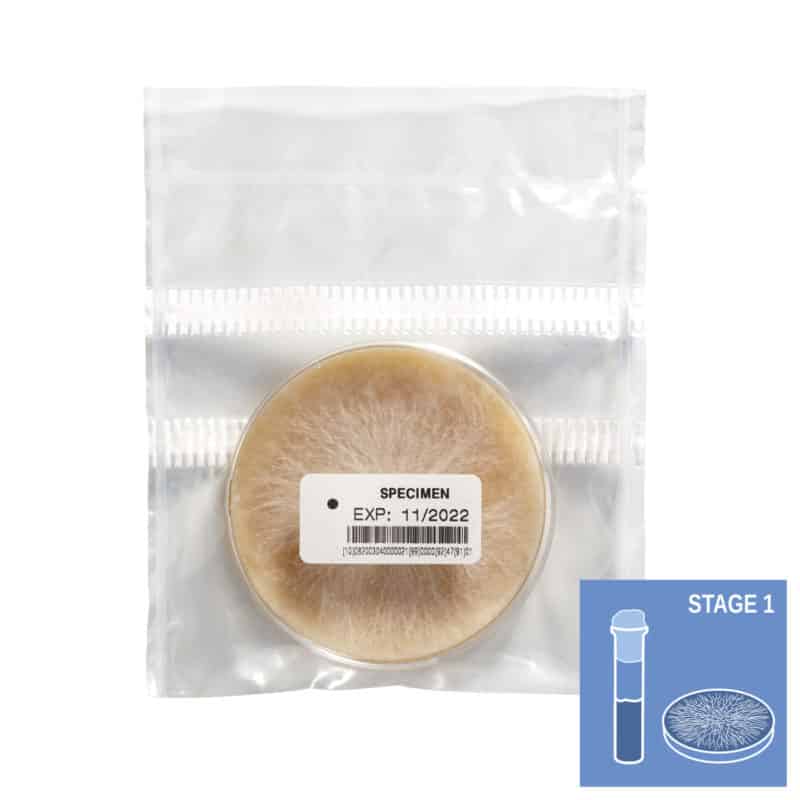
PETRIDISHES, TEST TUBES AND CRYOVIALS
Transported by courier. Cultures and cryovials are less sensitive to overheating than spawn and can be shipped all year round as long as the outside temperature is below 30°C (86°F) and as long as they are kept out of the sun.
MOTHER SPAWN | STAGE 2
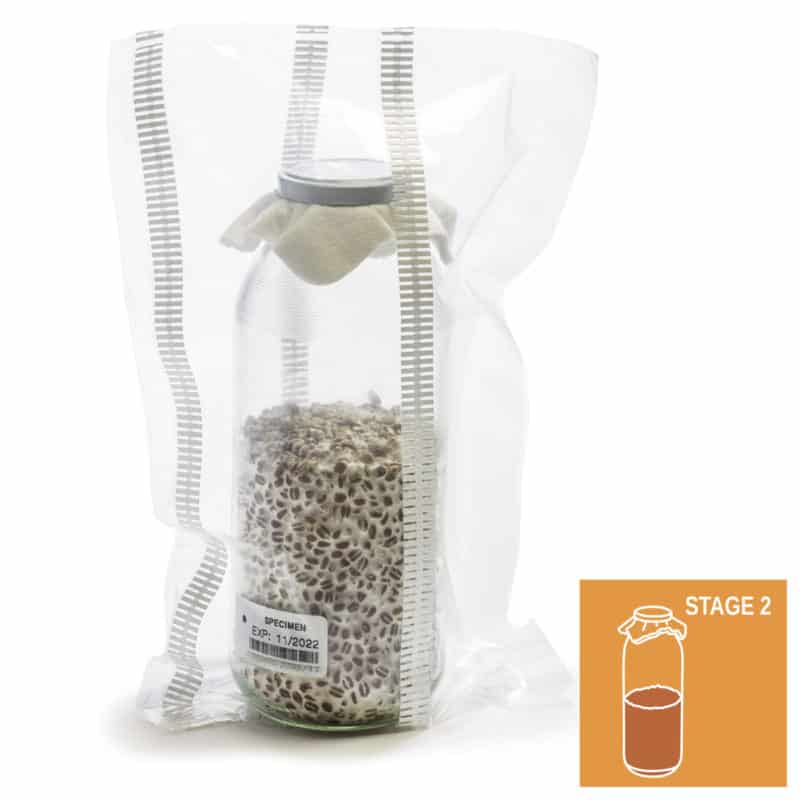
BOTTLE AND LIQUID
Transported by courier. Bottles are not so sensitive to overheating and can be shipped most of the year as long as the outside temperature is below 30°C (86°F) and as long as they are kept out of the sun.
MOTHER SPAWN | STAGE 3
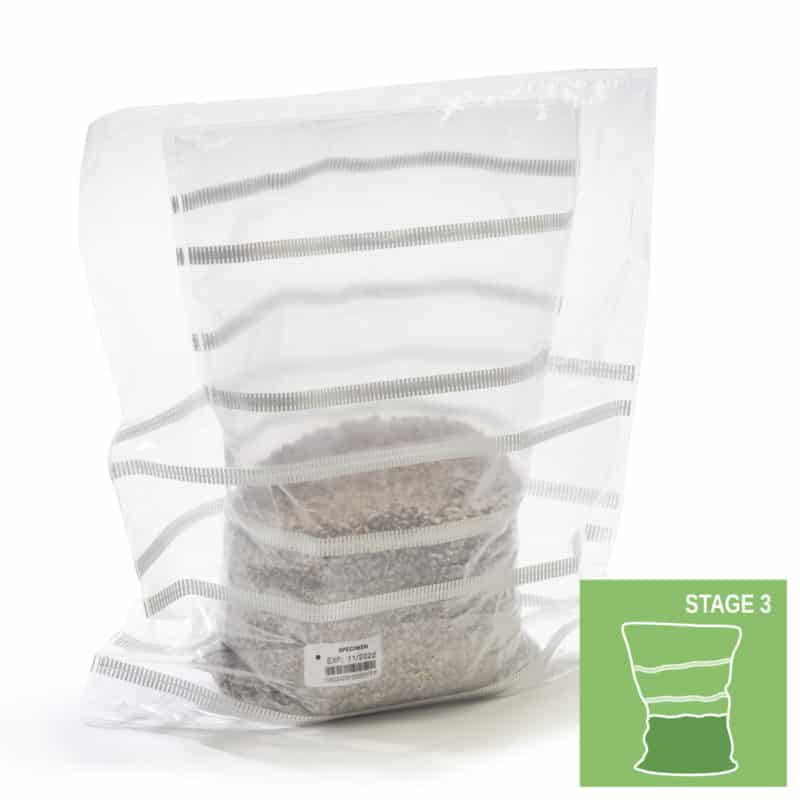
5000 ML BAG
WEIGHT PER BAG: 2,8 – 3,5 KG (DEPENDING ON RECIPE)
Courier freight
Not refrigerated. No shipments during summer.
4 bags/box = 20 litres = 11,2 to 14 kg
Pallet freight (>18 bags) Refrigerated transport all year. Fixed price per pallet depending on delivery address.
3 bags/box = 25 litres = 8,4 to 10,5 kg
36 boxes/europallet = 108 bags = 540 liters = 302 to 378 kg
SPAWN | STAGE 4
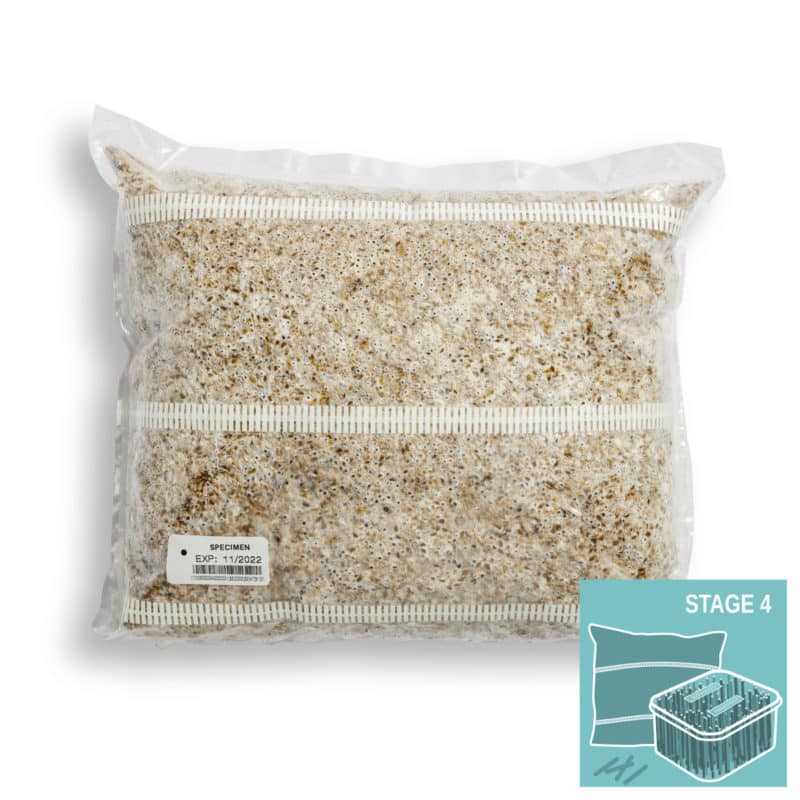
5L BAG
WEIGHT PER BAG: 2,8 – 3,5 KG (DEPENDING ON RECIPE)
Courier freight
Not refrigerated. No shipments during summer.
4 bags/box = 20 litres = 11,2 to 14 kg
Pallet freight (>24 bags)
Refrigerated transport all year. Fixed price per pallet depending on delivery address.
5 bags/box = 25 litres = 14 to 17,5 kg
36 boxes/europallet = 180 bags = 900 liters = 504 to 630 kg
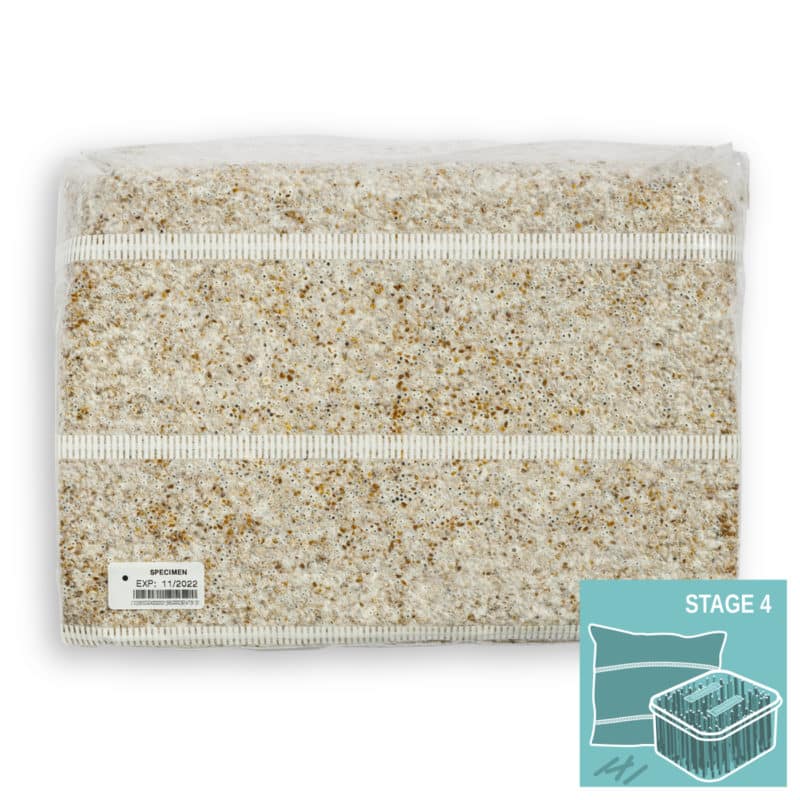
10L BAG
WEIGHT PER BAG: 5,6 – 7 KG (DEPENDING ON RECIPE)
Courier freight
Not refrigerated. No shipments during summer.
2 bags/box = 20 litres = 11,2 to 14 kg
Pallet freight (>12 bags)
Refrigerated transport all year. Fixed price per pallet depending on delivery address.
2 bags/box = 20 litres = 11,2 to 14 kg
48 boxes/europallet = 96 bags = 960 liters = 538 to 672 kg
Prices of larger quantities are to be discussed on a personal level.
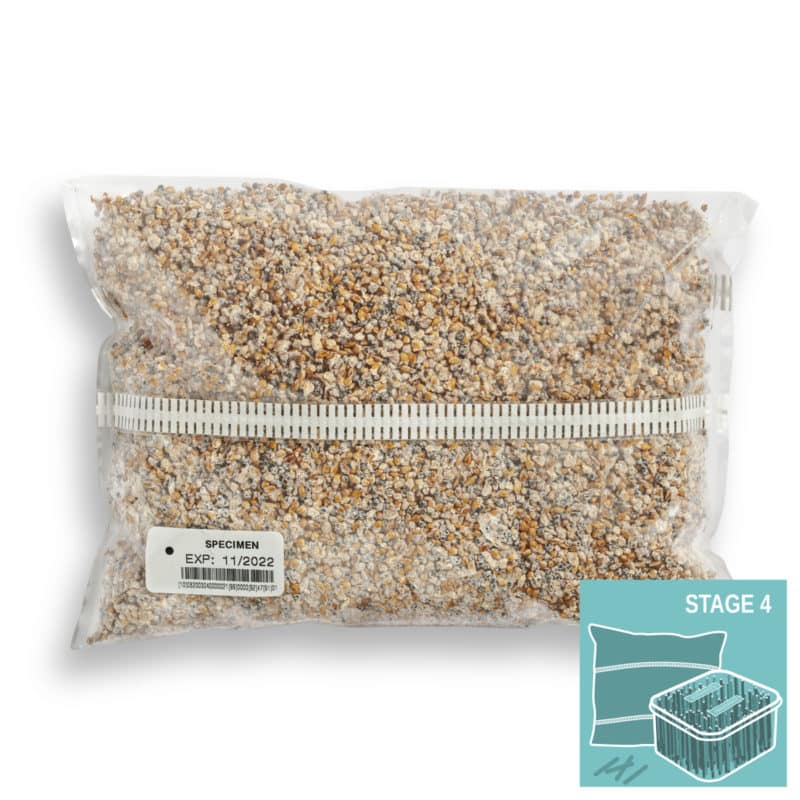
1L BAG
WEIGHT PER BAG: 0,5 – 0,68 KG (DEPENDING ON RECIPE)
Courier freight
Not refrigerated. No shipments during summer.
20 bags/box = 20 litres = 10 – 13,6 kg
Pallet freight (>120 bags)
Refrigerated transport all year. Fixed price per pallet depending on delivery address.
20 bags/box = 20 litres = 10 – 13,6 kg
36 boxes/europallet = 720 bags = 720 liters = 360 – 490 kg
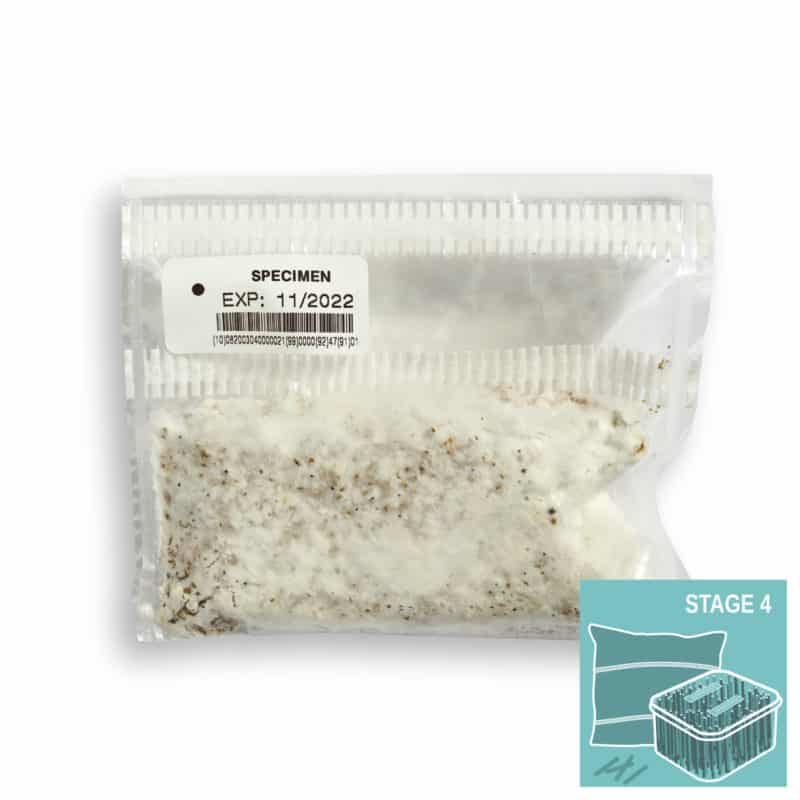
50 GR BAG
WEIGHT PER BAG: 50 GR
Courier freight
Not refrigerated. No shipments during summer. .
100 bags/box = 5 litres = 3 to 3,5 kg
Pallet freight (>600 bags)
Refrigerated transport all year. Fixed price per pallet depending on delivery address.
100 bags/box = 5 litres = 3 – 3,5 kg
36 boxes/europallet = 3600 bags = 180 liters = 108 – 126 k
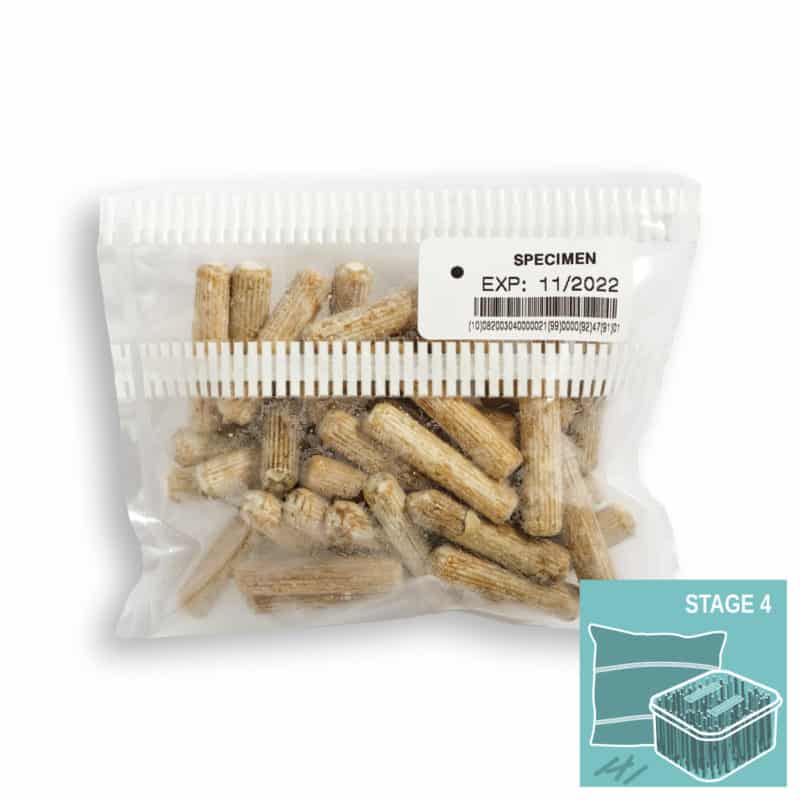
WOOD DOWELS - 50 PCS.
WEIGHT PER BAG: 0,14 – 0,15 KG
Courier freight
Not refrigerated. Limited risk of overheating, even in summer.
80 bags/box = 4000 pcs. = 11,2 – 12 kg
Pallet freight (>480 bags)
Refrigerated transport all year. Fixed price per pallet depending on delivery address.
80 bags/box = 4000 pcs. = 11,2 – 12 kg
36 boxes/europallet = 2880 bags = 144.000 pcs. = 403 – 432 kg
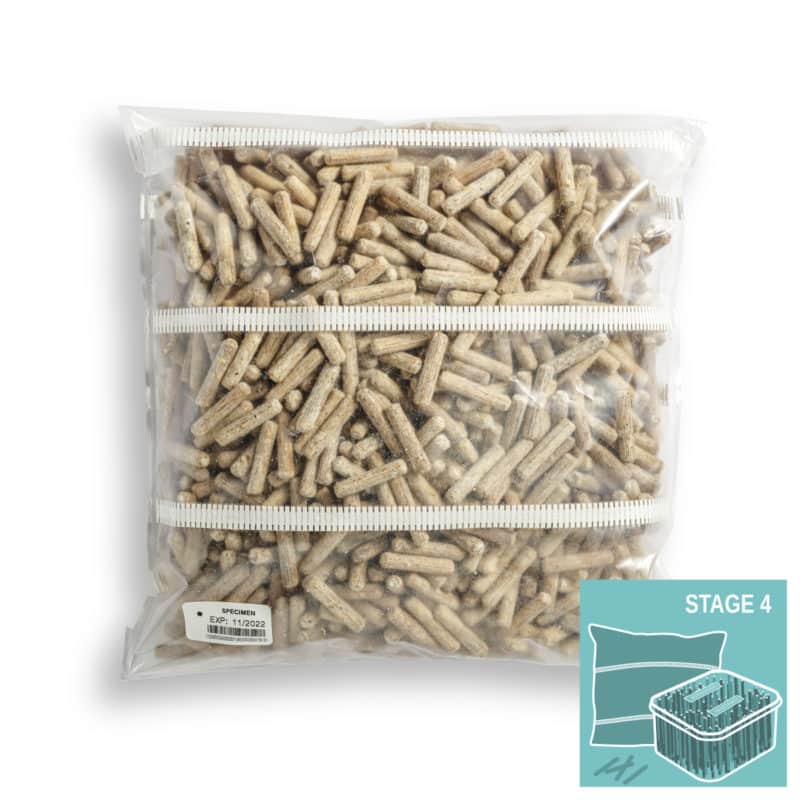
WOOD DOWELS - 1000 PCS.
WEIGHT PER BAG: 2,8 – 3 KG
Courier freight
Not refrigerated. Limited risk of overheating, even in summer.
4 bags/box = 4000 pcs. = 11,2 – 12 kg
Pallet freight (>24 bags)
Refrigerated transport all year. Fixed price per pallet depending on delivery address.
5 bags/box = 5000 pcs. = 14 – 15 kg
36 boxes/europallet = 180 bags = 180.000 pcs. = 504 – 540 kg
About us
Mycelia is a biotechnology company that produces your mycelium at different stages of development: mother cultures, mother spawn and spawn. Our spinoff Mycelia Academy can assist you with consultancy and training. Our R&D department Mycovision can help you develop your products for the mushroom industry or biocontrol market. Read more
SIGN UP TO OUR NEWSLETTER
Receive updates about mushroom spawn and research innovations.
Proud organisers of the WoodFungi Conference

Stage 1 mother culture
PRODUCTS:
– tube
– petri dish
– cryovial
USE:
– Use this product to produce your STAGE 2
Stage 2 mother spawn
PRODUCTS:
– syringe (15 ml)
– syringe (500 ml)
– bag (1000 ml)
USE:
– Use this product to produce your STAGE 3
Stage 3 Inoculum
PRODUCTS:
– bag (5000 ml on grains)
USE:
– Use this product to produce your STAGE 4
Stage 4 spawn
PRODUCTS:
– 50GR, 1L, 5L and 10L bag
– wood dowels 50, 500 and 1000 pcs
– syringes
USE:
– Use this product to produce your STAGE 5
– Final product: biocontrol / biostimulants / Cordyceps substrate
Stage 5 substrate /Mycomaterials
We do not sell substrate or mycomaterials.
Stage 6 mushrooms
We do not sell mushrooms.